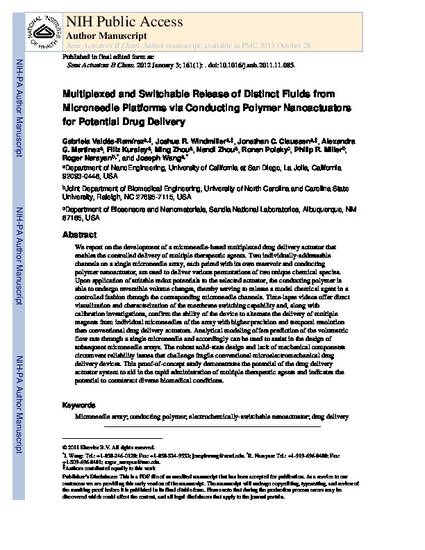
Article
Multiplexed and Switchable Release of Distinct Fluids from Microneedle Platforms via Conducting Polymer Nanoactuators for Potential Drug Delivery
Sensors and Actuators B: Chemical
(2012)
Abstract
We report on the development of a microneedle-based multiplexed drug delivery actuator that
enables the controlled delivery of multiple therapeutic agents. Two individually-addressable
channels on a single microneedle array, each paired with its own reservoir and conducting
polymer nanoactuator, are used to deliver various permutations of two unique chemical species.
Upon application of suitable redox potentials to the selected actuator, the conducting polymer is
able to undergo reversible volume changes, thereby serving to release a model chemical agent in a
controlled fashion through the corresponding microneedle channels. Time-lapse videos offer direct
visualization and characterization of the membrane switching capability and, along with
calibration investigations, confirm the ability of the device to alternate the delivery of multiple
reagents from individual microneedles of the array with higher precision and temporal resolution
than conventional drug delivery actuators. Analytical modeling offers prediction of the volumetric
flow rate through a single microneedle and accordingly can be used to assist in the design of
subsequent microneedle arrays. The robust solid-state design and lack of mechanical components
circumvent reliability issues that challenge fragile conventional microelectromechanical drug
delivery devices. This proof-of-concept study demonstrates the potential of the drug delivery
actuator system to aid in the rapid administration of multiple therapeutic agents and indicates the
potential to counteract diverse biomedical conditions.
Keywords
- Microneedle array,
- conducting polymer,
- electrochemically-switchable nanoactuator,
- drug delivery
Disciplines
Publication Date
January 3, 2012
DOI
10.1016/j.snb.2011.11.085
Publisher Statement
This is a manuscript of an article from Sensors and Actuators B: Chemical 161 (2012): 1018, doi:10.1016/j.snb.2011.11.085. © 2012. This manuscript version is made available under the CCBY-NC-ND 4.0 license http://creativecommons.org/licenses/by-nc-nd/4.0/
Citation Information
Gabriela Valdés-Ramírez, Joshua R. Windmiller, Jonathan C. Claussen, Alexandra G. Martinez, et al.. "Multiplexed and Switchable Release of Distinct Fluids from Microneedle Platforms via Conducting Polymer Nanoactuators for Potential Drug Delivery" Sensors and Actuators B: Chemical Vol. 161 Iss. 1 (2012) p. 1018 - 1024 Available at: http://works.bepress.com/jonathan_claussen/25/
